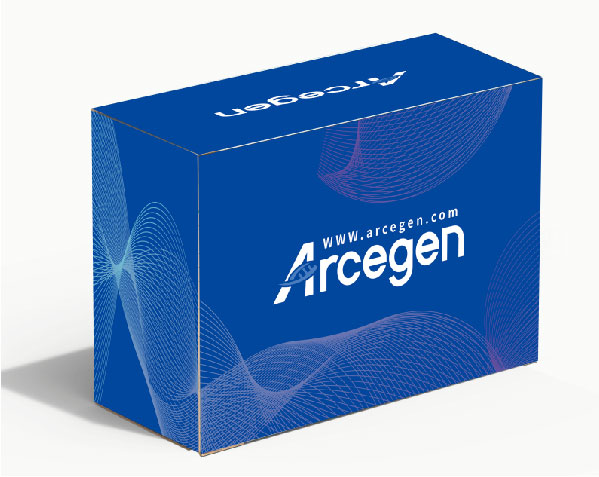Human BMP-7 ELISA Kit
Product description
Human Bone Morphogenetic Protein-7 (Human BMP-7) is a member of the TGF-β superfamily and is considered one of the most potent synthetic factors for chondrocytes. The growth factor domain of human BMP-7 shares 98% amino acid sequence identity with mouse and rat BMP-7. BMP-7 acts in various organ systems. It promotes new bone formation and the development of renal units, inhibits differentiation of prostate epithelium, and antagonizes epithelial-mesenchymal transition. Bone Morphogenetic Protein (BMP) signaling regulates a series of cellular processes and plays an important role in early embryonic patterning. It is known that BMP-7 expression has a protective effect on renal injury during diabetic nephropathy and disappears in the early stages of diabetic nephropathy progression. Potential clinical applications of BMP-7 include its neuroprotective effects in stroke animal models.
The Arcegen Human BMP-7 ELISA (Enzyme-Linked Immunosorbent Assay) Kit is an in vitro enzyme-linked immunosorbent assay kit used for quantitatively measuring BMP-7 in serum, plasma, and cell culture supernatants. Specific anti-BMP-7 antibodies are precoated onto high-affinity enzyme plates. Standard samples and test samples are added to the enzyme plate wells and incubated. BMP-7 in the samples binds to the solid-phase antibodies. After washing away unbound substances, detection antibodies are added and incubated, followed by washing and addition of enzyme conjugate (Streptavidin-HRP) for incubation. After washing, TMB substrate solution is added for color development in the dark. The intensity of the color reaction is directly proportional to the concentration of BMP-7 in the sample. The reaction is terminated by adding a stop solution, and the absorbance is measured at a wavelength of 450 nm (with a reference wavelength of 570 - 630 nm).
Specifications
|
Item Number |
P162014S / P162014E |
|
Specification |
48 T / 96 T |
|
Detection Range |
62.5-4000 pg/mL |
|
Detection Method |
Sandwich ELISA |
|
Detection Time |
4.5 hours |
|
Sensitivity |
44.6 pg/mL |
|
Dilution Linearity |
86 - 127% |
|
Recovery Rate |
81 - 126% |
|
Intra-assay Variability |
3.3% |
|
Inter-assay Variability |
4.2% |
Components
|
Component Number |
Component Name |
Storage Temperature |
P162014S |
P162014E |
|
P162014-A |
ELISA Plate |
2~8℃ |
48 T |
96 T |
|
P162014-B |
Standard |
2~8℃ |
1 tube |
2 tubes |
|
P162014-C |
Detection Antibody |
2~8℃ |
60 μL |
120 μL |
|
P162014-D |
Enzyme Conjugate |
2~8℃(Avoid Light) |
30 μL |
60 μL |
|
P162014-E |
Sample Dilution Buffer |
2~8℃ |
8 mL |
15 mL |
|
P162014-F |
Antibody/Enzyme Dilution Buffer |
2~8℃ |
15 mL |
30 mL |
|
P162014-G |
20x Wash Buffer |
2~8℃ |
25 mL |
50 mL |
|
P162014-H |
Substrate Solution |
2~8℃(Avoid Light) |
8 mL |
15 mL |
|
P162014-I |
Stop Solution |
Room Temperature |
5 mL |
10 mL |
|
P162014-J |
Plate Sealant Film |
Room Temperature |
3 pieces |
5 pieces |
Storage
The kit can be stored at 2~8℃ or according to the storage conditions provided in the component information to avoid contamination and repeated freeze-thaw cycles. Diluted working concentration reagents should be used immediately and discarded, and they should not be reused. The shelf life is 1 year.
Table 1.Reagent Storage Table After First Use
|
Component Name |
Storage Conditions |
|
ELISA Plate |
Unused strips can be returned to the aluminum foil bag,tightly sealed,and stored at 2-8°C to avoid moisture absorption. |
|
Standard |
Use within 48 hours after dissolution,store at 2-8°C to avoid contamination. |
|
Detection Antibody |
Use within 48 hours after dilution,store at 2~8°C to avoid contamination. |
|
Enzyme Conjugate |
|
|
Sample Dilution Buffer |
Store at 2~8°C for 1 month,avoiding contamination.
|
|
Antibody/Enzyme Dilution Buffer |
|
|
20x Wash Buffer |
|
|
Substrate Solution |
Store at 2~8°C for 1 month,avoiding light exposure. |
|
Stop Solution |
Can be stored at room temperature. |
|
Plate Sealant Film |
Catalog No.:*
Name*
phone Number:*
Lot:*
Email*
Country:*
Company/Institute:*
Related articles

